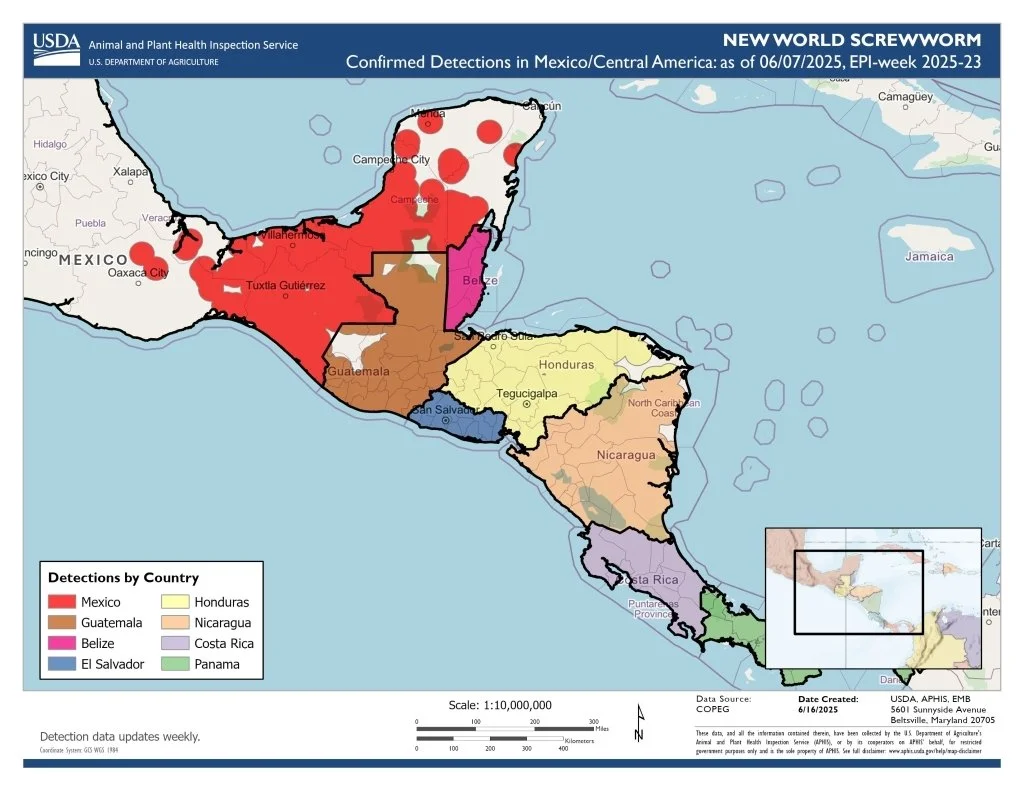New World Screwworm
Frequently Asked Questions
-
New World Screwworm are blow fly larvae that infest the living tissue of warm-blooded animals causing a condition know as myiasis. Female flies lay eggs on or near open wounds, body orifices, or decaying tissue. The larvae hatch and burrow into the host's tissues, feeding on live flesh and causing inflammation and tissue damage.
-
New World Screwworm infestations can occur in all livestock, horses, wildlife, poultry, and other mammals. Humans can also be hosts to the New World Screwworm.
-
Female flies lay eggs on living animals at the edge of wounds or mucous membranes such as nostrils, ears, eyes, mouth, or genitalia. Eggs hatch and the larvae burrow into tissue and continue to feed and grow. As the larvae feed on the host, damage is caused by sharp mouth hooks, making the wound larger and deeper. Larvae fall from the wound, bury in the ground to pupate, then emerge as new flies to breed and infect new hosts.
-
Flies are able to travel long distances to find a suitable host, up to 10 - 12 miles. The movement of infested livestock or wildlife can lead to spread over even longer distances.
-
Adult Flies:
Metallic blue-green appearance
About 2-3 times larger than house flies
Orange or yellow face
Three dark stripes on back
Larvae (Maggots):
Cream to pink colored
Cylindrical, tapered shape
Distinct bands of spines around body segments
Found in wounds, feeding on living tissue
-
Signs in animals include:
Foul-smelling wounds
Maggots in wounds
Enlarged wounds
Animal distress
Loss of appetite
Fever
-
Any open wound or blood source can become an infestation site.
Common sites include:
Umbilical Regions
Castration Wounds
Branding Locations
Ear Tags
Ear Notching or Marking
Genitalia
Dehorning Wounds
Any Cuts, Scrapes, or Open Wounds
-
The Sterile Insect Technique (SIT) is the most effective way to prevent the New World screwworm. However, there is not enough sterile fly production at this time.
Livestock owners should take the following precautions with all livestock:
Inspect animals daily for wounds
Treat all wounds immediately
Use approved insecticides around wounds
Maintain proper sanitation
Control fly populations
General Prevention:
Use fly repellents
Schedule procedures such as castration and calving during cooler months
Monitor imported animals carefully
-
If you suspect your animals have a New World Screwworm infestation, please contact your local veterinarian. They can safely collect samples and coordinate with USDA and state animal health officials to verify the presence of New World Screwworm.
-
As of June 1, 2025, USDA has not approved any products to treat and prevent New World Screwworm.
-
As of June 1, 2025, there are no animal movement restrictions for animals with New World Screwworm.
Free Resources
New World Screwworm Poster
Download pdf (8.5” x 11” pdf), 1 MB
Download pdf (24” x 36” pdf), 20 MB
Download image, 6 MB
Links
COPEG Site (Panama - United States Commission for the Eradication and Prevention of Screwworm)
Current Map
Dinar Bud, Getty Images
New World Screwworm Lifecycle
Photo source: USDA APHIS. STOP Screwworms: Selections from the Screwworm Eradication Collection, Special Collections, National Agricultural Library





